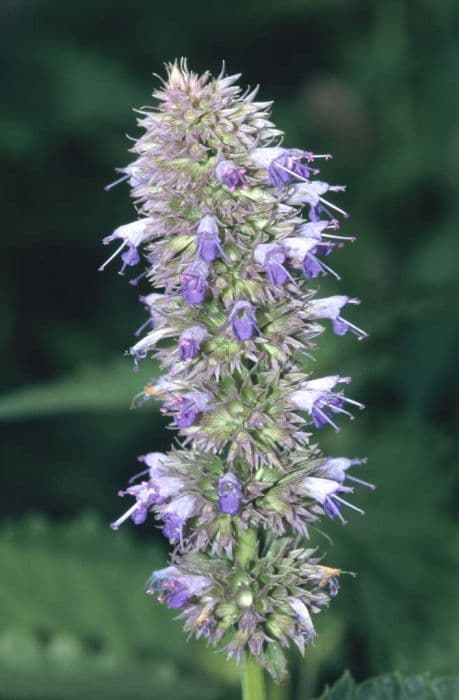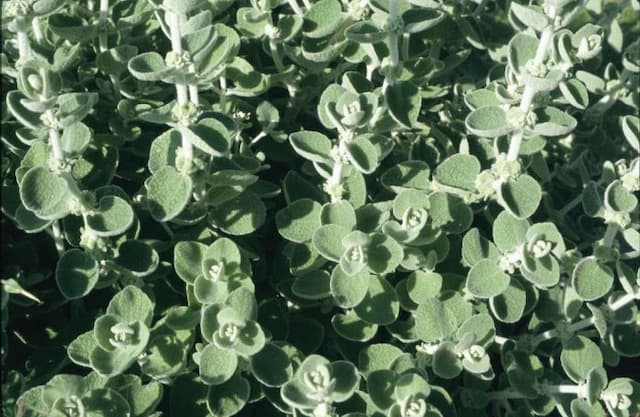Lamb's ear Stachys byzantina

ABOUT
S. byzantina is a carpeting, evergreen perennial, with thick, soft, oblong-elliptic leaves and stems densely white-woolly. Basal leaves are to 10cm long, in rosettes, flowering stems erect to 50cm in height. Flowers are purplish or pink, sometimes appearing striped, arranged in many-flowered whorls in an interrupted spike in summer. Several selections with varying leaf and flower colour are available. A valuable foliage plant
About this plant
 Names
NamesFamily
Lamiaceae.
Synonyms
Lamb's-ear, Woolly Hedgenettle, Lamb's Tongue, Silver Carpet, Fuzzy Wuzzy.
Common names
Stachys byzantina K.Koch, Stachys lanata Jacq., Stachys olympica Poir., Stachys germanica subsp. byzantina (K.Koch) Briq.
 Characteristics
CharacteristicsLife cycle
Perennials
Foliage type
Deciduous
Color of leaves
Silvery-green
Flower color
Purple
Height
1-2 feet (30-60 cm)
Spread
1-2 feet (30-60 cm)
Plant type
Herb
Hardiness zones
4-9
Native area
Turkey Iran
Benefits
 General Benefits
General Benefits- Drought-tolerant: The plant requires minimal watering once established, making it suitable for dry climates or water-conserving gardens.
- Low maintenance: It does not require frequent care, such as fertilizing or pruning, saving time and effort for gardeners.
- Groundcover: Its dense foliage helps suppress weeds and cover bare spots in the garden, reducing the need for mulching.
- Erosion control: The plant's root system can help stabilize soil on slopes and banks, preventing erosion.
- Texture in landscaping: The fuzzy, silver-colored leaves add a unique texture and contrast to garden designs.
- Attracts pollinators: The flowers can attract bees and butterflies, promoting biodiversity and a healthy ecosystem.
- Edging plants: Stachys byzantina works well for creating defined edges along pathways or garden beds.
- Deer resistant: The plant is typically not favored by deer, making it a good choice in areas where deer browsing is a problem.
- Propagation ease: It can be easily propagated by division, making it simple to expand or share with other gardeners.
- Seasonal interest: It provides visual interest throughout the growing season, especially when in bloom.
 Medical Properties
Medical Properties- Anti-inflammatory: Stachys byzantina is believed to contain compounds that may help reduce inflammation.
- Antimicrobial: Extracts from the plant are said to exhibit antimicrobial properties against certain bacteria and fungi.
- Astringent: The plant has traditionally been used as an astringent to constrict tissues and reduce bleeding or secretions.
- Emollient: Lamb's ear, with its soft leaves, is sometimes used as a gentle emollient for skin conditions.
- Wound healing: There are anecdotal reports of the leaves being used in traditional medicine for their wound healing effects.
 Air-purifying Qualities
Air-purifying QualitiesThis plant is not specifically known for air purifying qualities.
 Other Uses
Other Uses- Lamb's ear can be used as a natural bandage due to its soft, absorbent leaves which are gentle on the skin.
- The soft foliage can serve as a cushioning material when shipping fragile items to protect them from damage.
- Gardeners sometimes use Lamb's ear as a 'stepping stone' plant, creating a soft, living pathway through their garden.
- The plant's dense growth can be utilized as a living mulch to suppress weeds and retain soil moisture in garden beds.
- Lamb's ear leaves can be used in crafts, such as making wreaths or as a natural filler in floral arrangements.
- In educational settings, the plant is sometimes used to teach children about plant textures in sensory gardens.
- The silver-furred leaves can be incorporated into costumes or clothing as a decorative, nature-inspired element.
- Lamb's ear can be planted in areas prone to erosion to help stabilize the soil with its root system.
- Its low-growing, spreading habit makes Lamb's ear useful as a ground cover for steep banks where mowing is difficult.
- The aesthetic appeal of Lamb's ear is employed in landscape design, providing a contrast to darker foliage plants.
Interesting Facts
 Feng Shui
Feng ShuiThe Lamb's Ear is not used in Feng Shui practice.
 Zodiac Sign Compitability
Zodiac Sign CompitabilityThe Lamb's Ear is not used in astrology practice.
 Plant Symbolism
Plant Symbolism- Protection: With its dense and woolly foliage, Lamb's Ear is often associated with safety and protection, offering a shield or barrier against negativity and harm.
- Healing: Historically used for its antibacterial properties and as a bandage for wounds, Lamb's Ear symbolizes healing both physically and emotionally.
- Softness: The soft, velvety leaves of the Lamb's Ear plant can represent tenderness, kindness, and a gentle touch in interpersonal relationships.
- Peace: The Lamb's Ear can be a symbol of tranquility and calm, reflecting its ability to soothe with its plush texture.
 Water
WaterLamb's ears should be watered deeply once a week, providing enough water to soak the soil around the roots. In drier conditions, watering twice a week may be necessary, especially during the peak of summer. Ensure that the plant receives approximately one inch of water per week, either through rainfall or manual watering. It's important not to overwater, as Lamb's ears prefer drier conditions and are drought-tolerant. In winter, reduce watering frequency to prevent root rot, as the plant requires less moisture during this dormant period.
 Light
LightLamb's ears thrive in full sun to partial shade, with a preference for bright, direct sunlight for at least six hours each day. The best spot for the plant would include some afternoon shade in regions with very hot summers to prevent the leaves from scorching. However, too much shade may lead to leggy growth and reduce the plant's overall vigor.
 Temperature
TemperatureLamb's ears prefer moderate temperatures and can generally tolerate conditions between 60 to 80 degrees Fahrenheit. They can survive slight dips below freezing but may be damaged by prolonged exposure to temperatures below 20 degrees Fahrenheit. The optimal temperature range promotes healthy growth and preserves the soft, velvety texture of the foliage.
 Pruning
PruningPruning Lamb's ears is primarily done to maintain the plant's appearance and remove spent flower spikes. Trim back the foliage in late winter or early spring to encourage fresh growth and improve air circulation. Deadheading, or removing the old flower stalks after blooming, can be done in summer to prevent self-seeding and to keep the plant looking tidy.
 Cleaning
CleaningAs needed
 Soil
SoilLamb's Ear requires well-draining soil with a neutral to slightly alkaline pH, between 6.5 and 7.5. The best soil mix is one part garden soil, one part compost or well-rotted manure, and one part sharp sand or perlite for drainage.
 Repotting
RepottingLamb's Ear does not need to be repotted frequently, as it is typically grown as a perennial outdoor plant. Repot only when the plant outgrows its current container, which might be every 2-3 years.
 Humidity & Misting
Humidity & MistingLamb's Ear prefers a low to moderate humidity environment and is fairly drought tolerant. It thrives in dry air and does not require high humidity levels to grow well.
 Suitable locations
Suitable locationsIndoor
Place Lamb's Ear in a sunny spot with light, well-draining soil.
Outdoor
Plant Lamb's Ear in full sun with well-draining soil and space for spread.
Hardiness zone
4-8 USDA
 Life cycle
Life cycleStachys byzantina, commonly known as Lamb's Ear, begins its life cycle as a seed which germinates in warm soil during spring or early summer. The seedlings develop into a rosette of fuzzy, silver-grey leaves that form a ground-hugging mat. In its second year of growth, the plant produces a flowering stalk during early to mid-summer, bearing small, purplish-pink flowers favored by bees and other pollinators. After flowering, seeds are produced which may fall to the ground to self-sow or be dispersed by wind and animals, allowing new plants to emerge in the vicinity. Larger Lamb's Ear plants may also propagate vegetatively by division of the root system, facilitating the spread of the plant within a garden. The plant is a perennial and will go dormant in winter, with its foliage dying back, but it will re-emerge from its root system again in the spring.
 Propogation
PropogationPropogation time
Spring to early summer
Lambs' ears, known scientifically as Stachys byzantina, can be easily propagated through division, which is the most widely used method. The best time to propagate lambs' ears by division is in either early spring or early fall when the plant is not in active bloom. To propagate by division, carefully dig around the clump of lambs' ears, ensuring you get a good portion of the root system, then gently separate the clump into smaller sections with your hands or a sharp knife. Each section should have a decent amount of roots attached. After division, plant the new sections in well-draining soil at the same depth they were previously growing and water them thoroughly. Divisions should be spaced about 12 to 18 inches (approximately 30 to 45 centimeters) apart to allow for growth. This method of propagation is straightforward, cost-effective, and helps to rejuvenate older plants that may have become woody or less vigorous in the center.









